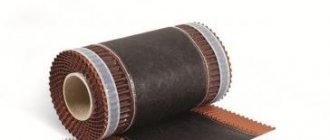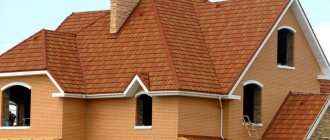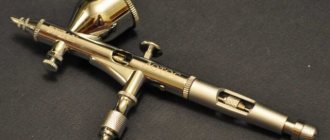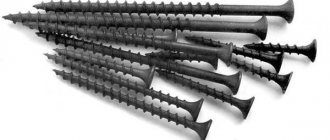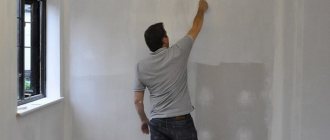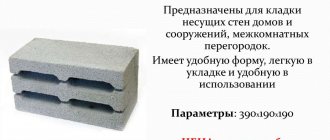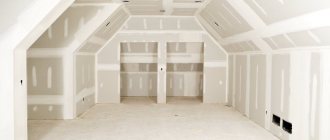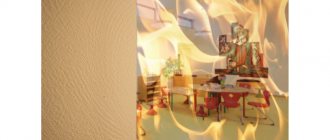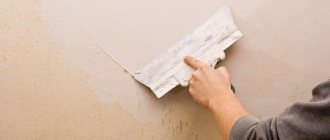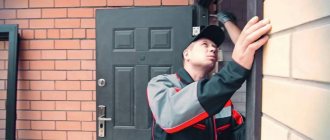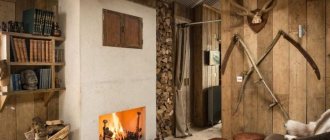The roof of the house keeps the house dry and comfortable. Recently, metal tiles have become especially popular. This material has many advantages, including ease of installation, long service life and a variety of colors, allowing you to make the most suitable roof for the facade of the house. However, in addition to the advantages, metal tiles have one, but significant disadvantage: insufficient sound insulation. The thin-sheet canvas fully transmits the sound of rain, hail, and even gusts of wind can be heard inside the house. To reduce the acoustic effect, it is necessary to properly soundproof the roof of the house, taking into account the characteristics and features of the material. In this material we will try to figure out how to create comfortable conditions in a house with a metal roof.
Photo: Covering the roof with metal tiles. Author: Dmitry Kostev
Distinctive features of metal roofing
Metal roofing tiles are nothing more than a sheet of thin metal coated with a layer of polymer coating. The material is produced using a special press, which gives the surface a certain texture. In appearance, such a sheet resembles ceramic tiles, which cost a lot of money and a special installation technology. The roof slope for tiles should be between 15 and 45 degrees. Metal tiles are installed from the bottom row to the top row with an overlap to ensure the maximum degree of waterproofing. Speaking about the advantages of metal tiles, the following should be noted:
- Lifetime. According to the manufacturers of metal tiles, the service life of the material is thirty years, but in practice it is clear that even after half a century, the reliability and beauty of the roof remains the same as only after installation.
- Weather resistant. A metal tile roof is not afraid of temperature changes and other weather conditions. Thanks to the galvanized base and polymer coating, the product is not subject to corrosion and loss of external qualities. It is also worth noting that the polymer coating of the sheets protects the structure from ultraviolet radiation.
- Strength indicator. As you know, metal is one of the materials that can withstand heavy loads without losing its shape and characteristics. Also, metal sheets of metal tiles are resistant to mechanical damage.
- Lightness of the material. Despite the fact that metal tiles consist of sheet metal, its thickness is small, averaging 6.5 kilograms per square meter. Thanks to this quality, metal tiles can be installed without using special lifting mechanisms and devices. It is enough to have a couple of assistants to do the roofing yourself.
Photo: Roof sound insulation. Author: Dmitry Kostev
This is interesting! Metal tiles are a relatively inexpensive roofing option, but if you count the costs of thermal insulation, sound insulation and other types of work, the price of the roof will cost the owner a pretty penny.
Requirements for soundproofing materials
You can make a soundproofing finish for an iron roof using various materials. There is no universal remedy; each case requires an individual approach. Main selection criteria:
- Strength. The product must maintain its integrity under mechanical stress.
- Lack of response to changes in humidity levels and temperature changes.
- Resistance to ultraviolet radiation. The material must not decompose or release toxic substances when heated.
- A product of sufficient thickness will help make the balcony silent.
- A simple and reliable fastening can facilitate the process of soundproofing a roof.
Fulfillment of all conditions will ensure the reduction or complete disappearance of sounds from rain and wind.
The main causes of roof noise
Metal sheets of metal tiles have a high degree of resonance, which ultimately leads to uncomfortable conditions inside the structure. If it is raining or hailing outside, then with such noise it will be difficult to hear each other. This effect occurs due to a thin layer of roofing material and the problem can only be solved with high-quality and reliable sound insulation.
Photo: Sectional view of roof sound insulation. Author: Dmitry Kostev
However, not only weather conditions can create unpleasant noise, it is also caused by improper installation of roofing material and the entire roof structure. Having defects in the design, and noise from weather conditions will only intensify it. The most common reasons for work may be:
- Uneven sheathing design. When a roof sheathing is being formed, quite often few people pay special attention to the beams used in the structure. There are situations where different thicknesses of wood material lead to an uneven fit of the roofing material, and the sagging part will create a resonant sound even with a weak wind.
- Material fastening technology. Sometimes there are situations when specialists are invited to carry out installation work so that they do everything quickly and efficiently. Unfortunately, there are irresponsible contractors who, in order to save time, fix metal tile sheets with a small number of fasteners. An insufficient number of fasteners leads to vibration from the wind and a loud sound will be heard in the house.
- Thermal expansion of materials. Some inexperienced, self-taught craftsmen try to tighten the fastening screws all the way, which can lead to the formation of creaks and cracks. The thing is that each type of material can expand due to temperature, and if the metal is completely clamped, then as the temperature increases, unpleasant cracks and sounds appear.
Advice: when designing a roof, it should be taken into account that the sharper the roof angle, the greater the resonance effect. The thing is that, according to the laws of physics, drops roll off the surface, thereby adding to the sound amplification.
You can completely get rid of roof sounds by using effective and reliable sound insulation, as well as by calling professional craftsmen who will carry out all installation work quickly and efficiently.
What kind of noises are there?
There are several types of noise: shock, structural and airborne. In addition, they have different ranges, which are expressed in low, mid and high frequencies. Let's talk in more detail about how to protect yourself from each type of noise.
Air
It is expressed in certain sounds that come from the street and then spread throughout the room.
To protect against such phenomena, a building envelope is constructed consisting of several layers:
- The external one is designed to reflect sounds. Only hard materials are suitable for its arrangement. The walls of the attic floor can be sheathed with plywood or OSB; the best roofing material in this case would be tiles or Euro slate.
- The internal one should absorb sound. Mineral wool is perfect here, as in addition to sound absorption, it provides high-quality thermal insulation.
- For windows, double-glazed windows with several glasses would be an excellent option; for doorways, creating vestibules would be better.
- Floors are insulated from noise using mineral wool.
Shock
It represents noise during heavy rains or falling branches on the roof of a wooden house.
The least noise in the room is created when using slate and tiles (ceramic), the greatest noise is created if corrugated sheets or metal tiles are used as roofing material. Sound insulation of the attic in this case is organized thanks to an elastic substrate.
Structural
It occurs when serious mistakes are made during the construction of the supporting structure of a wooden house, as well as the arrangement of the water supply and heating system.
Here, the best solution for finishing materials for ceilings and walls would be lining (made of wood) or plasterboard. The pipes are attached to the main structure only with clamps.
Soundproofing material
Today, there is so much choice of roofing materials offered on the market that it is quite difficult to choose, something specific is very difficult. The same situation occurs with soundproofing materials. An individual roof is developed for each project to create optimal living conditions. In order not to dive into the intricacies and characteristics of each material, it is worth considering the selection criteria:
- efficiency;
- durability;
- interaction with aggressive environments;
- fire safety.
Photo: Sectional view of roof sound insulation.
Author: Dmitry Kostev When choosing a material for high-quality sound insulation, first of all, you need to understand what effect the owner of the house expects. It’s probably no secret that reliable and effective sound insulation can be achieved through an integrated approach. If the construction budget is not limited, then multilayer insulation will reduce the sound level as much as possible.
Today, fiber-based products are considered the most effective insulating materials. In addition to soundproofing qualities, the material will also protect the roof from the cold.
Some tips from the professionals
- The roof is being erected for decades to come, so there is no point in saving on heat-insulating boards, which also provide effective sound insulation of the roof. Purchase high-quality soundproofing materials with a high sound absorption index.
- Use mineral wool materials in combination with new soundproofing methods that involve the use of special soundproofing fasteners when installing acoustic structures.
- Be sure to lay all layers of roofing “pie” recommended by experts. Don't think you can do without any of them. Each material has its own separate purpose.
- It is better to purchase all components of the roofing structure in one place in order to save on discounts and minimize the risk of purchasing a counterfeit product (this is practically impossible in large construction stores).
We recommend reading: Operable roofing: types, structure and coating
And in conclusion - the most important advice. Having spent a lot of money on the purchase of expensive roofing materials, do not skimp on hiring qualified specialists to install the roof. Professionals will do the work in strict accordance with the technology specified by the manufacturer in the instructions, and this guarantees peace and quiet in your home.
Required Tools
To install metal tiles, you must have all the necessary tools; only in this case will perfectly smooth corners and surfaces be cut. To soundproof metal tiles you will need the following:
- tape measure, ruler and pencil;
- screwdriver or drill with speed controller;
- hammer and screwdriver;
- construction stapler.
Having all the necessary tools and soundproofing materials at hand, you can complete all the work in a fairly short time, even with your own hands.
Troubleshooting options
As a rule, sound insulation is included in a set of measures when glazing a balcony, when the roof is insulated and sealed. A well-organized process provides protection from external sounds in adverse weather conditions. But if the work was carried out poorly and the roof on the loggia or balcony periodically begins to make noise, there is a need for additional sound insulation. The method for solving the problem directly depends on the cause of the extraneous sounds.
The most commonly used measures are:
- The canopy is soundproofed with soft polymers designed to reduce the sound of raindrops.
- In case of poor-quality fixation of the roof, additional strengthening of the structure is carried out.
- Change the angle of the canopy on the balcony.
- Incorrectly selected visor parameters require trimming.
Drastic measures include complete replacement of the metal visor with a plastic structure. It is easier to soundproof a loggia than a balcony. Typically, only the front part needs insulation, and the sides are left unchanged.
You can provide reliable sound insulation to your balcony roof with your own hands. Dismantling the decorative ceiling cladding is the most labor-intensive part. After the completion of the main stage of work, it will need to be returned to its original place.
When the decorative trim of the roof has been removed, a visual inspection of the quality of fixation of the metal roof is carried out. Existing gaps are eliminated with insulating material.
The surface of the canopy or canopy is cleaned of all contaminants. After which it is covered with the material chosen for sound insulation. Organization of work during the warm period does not require additional fixation measures. It is enough to remove the protective film and press the material with the adhesive side to the inner surface of the roof.
Comment! Low temperatures reduce the adhesive properties of the material, so it needs to be heated.
A blowtorch or a hair dryer will come to the rescue. If work with open fire is carried out indoors, you should take fire safety measures.
The source of the rumble may not necessarily be raindrops. Excessive width of the canopy is one of the reasons for annoying noise on the balcony. To ensure sound insulation, it is enough to leave a visor 15 cm wide and remove the excess area.
Poor quality fixation of the material on the roof is another reason for the formation of vibration and oscillations. If you seal the cracks and strengthen the fastenings, the sound insulation of the balcony will noticeably increase.
The sound insulation process itself is not difficult, but working at height is associated with a high risk to health and life. Therefore, it is better to entrust the arrangement of the balcony roof to industrial climbers who have the necessary skills and equipment to organize high-altitude work.
Sergey Novozhilov is an expert on roofing materials with 9 years of practical experience in the field of engineering solutions in construction.
One of the vulnerable parts of the house is the roof, because it is constantly exposed to atmospheric phenomena: precipitation, strong winds, temperature changes. Therefore, sound insulation of the roof of a house must be done very efficiently. To do this, you need to prepare the necessary tools and materials, as well as correctly perform sound insulation technology.
Common methods of sound insulation
Today there are two main methods of roof sound insulation. The first option involves laying insulating material directly under the sheets of metal tiles. This method is suitable if the roof is being laid from scratch, that is, when logs are installed and sheathing is done. The main advantage of this method is that insulation and soundproofing materials can be installed without unnecessary complications. Waterproofing, thermal and acoustic protection are laid on the open surface.
Photo: Sectional view of noise insulation of a metal tile roof. Author: Dmitry Kostev
You can also do sound insulation from the inside of the roof. In the second option, it will not be entirely convenient to install insulating materials, since it is not always possible to easily reach the far corners. The second option for sound insulation is applicable in cases where you purchased a house with metal tiles already installed, and there is no need to carry out major work. A roof that is wired from the inside is no less effective and reliable, but everyone decides for themselves what will be best for them.
What material to choose for sound insulation?
To create high-quality sound insulation for a metal roof, various materials can be used. When choosing, you should focus on the following parameters
:
- sound absorption index;
- dynamic modulus of elasticity.
The sound absorption index (SAI) is necessarily indicated by the manufacturer on the packaging of the material, in manuals and instructions, and the material itself can also be marked directly. The sound absorption index indicates the proportion of sound energy that an insulator can absorb. The higher this parameter, the more effective the use of this material.
The role of roof sound insulation is performed by thermal insulation materials. Today, polymer materials, in particular polystyrene foam and penoplex, are very popular. The sound absorption index of foam plastic sheets is only 0.3, which means that the material is unsuitable for sound insulation of roofs with a “loud” coating. The penoplex index is 0.5, which corresponds to the lower limit of applicability.
Cotton materials have an advantage in this component
:
- FROM glass wool – 0.6;
- FROM mineral wool – 0.7;
- FROM basalt fiber – 0.9.
Among the materials in the affordable price segment, these are the most effective options for sound insulation of metal tile roofing
.
The second parameter of soundproofing materials is the dynamic modulus of elasticity (DMU). The lower this indicator, the higher the acoustic protection. Eg:
- DMU foam 0.6-1.35;
- DMU mineral wool 0.3-0.35;
- DMU of basalt fiber and glass fiber from 0.05 to 0.25 (depending on the technological design and thickness of the material).
Taking into account both parameters, we can conclude that the noise from metal tiles is most effectively dampened by insulation made of basalt fiber, mineral wool or fiberglass. But it should be taken into account that purchasing a sound insulator made of basalt fiber will cost significantly more.
Installation of sound insulation - step-by-step instructions
Photo: Alternate laying of layers.
Author: Dmitry Kostev Effective roof sound insulation is considered to be that which is planned at the roof design stage. In this case, you can not only protect the house from airborne noise, but also vibration, which can be eliminated by using special shock-absorbing inserts under the sheathing. The progress of installation work consists of the following activities:
- Upon completion of the assembly work of the rafter base, a waterproofing layer is laid, which will ensure dryness and prevent leakage of the roof. As a waterproofing material you can use: polyethylene film, membrane-based material or construction roofing felt.
- The next stage of installation is nailing down the frame from the slats. To effectively protect the waterproofing layer, each lath on the underside must be treated with silicone or construction foam. Foam or silicone will protect the waterproofing from mechanical damage.
- Upon completion of installation of the slatted sheathing, sound insulation is installed. The sound insulation layer should not be wrinkled or compacted, as this may affect the effectiveness of the protection. After installing sound insulation, thermal insulation is installed. Foam plastic or penoplex can act as a thermal insulation layer. Thermal insulation is fixed directly to the rafters.
- The last stage of work is installing metal tiles.
With the right approach to roof installation, you can protect your house as reliably and effectively as possible from various noises coming from the roof.
Panel sound insulators
Scientific and technological progress offers us new building materials every year. Sound insulators are no exception. One of the new products is Izoplat slabs, made from coniferous wood, where not only tree trunks are used, but also pine needles and branches. Fibers are separated from them, which are then pressed into panels.
Isoplat panels for roof sound insulation Source e-t1.ru
The manufacturer offers several modifications of this material: for walls, floors, ceilings and roofs. In the latter case, these are panels lined with greenish cardboard, like waterproof plasterboard. Therefore, it is very easy to distinguish it from the rest.
Isoplat sound insulators are panels measuring 60x120 cm, the ends of which are equipped with a “groove-tenon” connecting lock, which allows you to install the material without cracks and gaps, forming a seamless plane. And for sound insulation this is very important.
As for installation, Isoplat panels are laid on top of the rafter system in a checkerboard pattern, as is done with OSB boards. They are attached to the rafter legs with wood screws. But soundproofing panels differ from OSB boards in that they are soft and cannot bear even the smallest loads. That is, they cannot be used under a continuous sheathing. In this case, it is not necessary to join adjacent soundproofing panels on the rafters.
Once the soundproofing layer has been laid, a counter-lattice is installed on top of the flooring. These are slats with a cross section of 50x50 mm, which are stuffed onto the rafter legs (lengthwise). After that, a waterproofing membrane or windproof film is installed, the purpose of which is to contain leaks that, for some reason, did not form on the metal roof. And the sheathing and roofing material are installed on top.
Soundproofing of a finished roof
There are situations when sound insulation needs to be carried out on a finished roof in the attic. The process of soundproofing such a room consists of three stages:
- Soundproofing material in the form of mats is placed in the opening between the rafters.
- For better fixation of insulating mats, it is necessary to cut the canvas ten centimeters longer so that the material fits more tightly into the opening and holds.
- Upon completion of laying the soundproofing boards, the entire surface is covered with a vapor barrier film. Wooden slats are also packed at a distance of 40 or 50 centimeters from each other.
Despite the fact that this installation method is more labor-intensive and complex, the sound insulation is excellent. Plus, the level of thermal insulation of the attic increases.
Interesting! A large amount of heat escapes through the attic, and you can save it by using sound insulation, because it is also an excellent insulator.
Soundproofing and soundproofing of attics. How to avoid mistakes?
The attic is affected by various types of sounds that come not only from the external environment, but also from the structure of the house. When performing soundproofing work, it is important to take into account all impact options and study them well.
Of course, most of the sound comes from the roof itself, but if you properly treat the surfaces you can minimize the level of impact. Also, do not forget that a lot of noise passes through the windows. In the attic, the location of window units can be different and the main requirement for such structures is high acoustic characteristics.
The correct installation of window units is also considered important. If the work is entrusted to professionals, the insulation characteristics will be high, and therefore the degree of noise insulation will be maximum.
As a rule, the roof has under-roof insulation, which also have sound insulation characteristics; if you use a combination of materials, you can achieve an optimal result.
At the moment, the abundance of materials allows you to select the most optimal building materials that meet the requirements and preferences of the home owner.
Soundproofing the attic floor
The attic itself is considered a cold room. When the entire house is heated in winter, most of the heat goes to the roof. The roof is cold and the air is warm, resulting in condensation. In addition to the fact that it can flow onto the floor forming yellow stains, moisture is the optimal place for the formation of fungus and mold.
This problem can be eliminated quite simply. A film is laid over the entire surface of the attic, blocking the passage of warm air to the cold. In addition to the fact that mold will not appear from moisture, all the heat to the maximum extent will remain in the house and not outside it.
Depending on how much the attic is visited, the floor covering can be made in the form of a walkway or completely covered with chipboard slabs. The main advantage of this type of sewing is that the result is a perfectly smooth floor and it absorbs vibration noise and airborne sounds well. When working with roofing, it is important to avoid the formation of cracks or poor fixation of roofing materials.
Only when everything is done according to all requirements can the maximum degree of protection of the attic from noise and other negative environmental influences be achieved.
Soundproofing the attic ceiling
To reduce noise levels in the attic, suspended ceilings can be used as an option. Of course, the design will be complex and it is necessary to carefully consider the dimensions, because the height of the ceiling in the attic is usually small and every centimeter is under attention.
The manufactured frame is filled with soundproofing boards, which act as heat and sound insulation. The installed building materials will provide the necessary level of comfort. The frame on the ceiling must be sewn up and absolutely any sheets can be used for this procedure.
It is good to use gypsum fiber for this purpose. Thanks to the porous base, such a ceiling will be able to more effectively retain street noise and sounds. You can also use plasterboard, decorative panels or gypsum structures as facing sheets.
Vibration isolation device
This type of insulation is used in the structure to absorb vibration sounds coming from the metal surface. The effect can be achieved if linings made of soundproofing material are installed under the joists. Despite the complexity of the proposed work, the efficiency will be maximum. With a vibration lining, the sound of rain hitting the roof is absolutely inaudible.
Some tips from the professionals
Considering that the roof is made for many years, it is worth saving on materials - this applies not only to construction materials, but also to noise insulation ones. It is advisable to choose high-quality insulating materials that meet all quality standards. Only if you use high-quality materials can you protect your home from sounds reliably and for a long time.
Photo: Sectional view of noise insulation of a metal tile roof. Author: Dmitry Kostev
Among the most effective heat and sound insulating materials are fiber boards and mats. Today, manufacturers offer a huge range of products that can be selected according to cost, characteristics and manufacturer. You need to buy from a trusted and reliable supplier who can provide valid documentation and product quality certificates.
Effective protection of the roof from sounds is the use of pie technology. Each layer of material is responsible for its function, and if something is missing, the degree of protection will be lower.
If you have spent a lot of money on purchasing high-quality soundproofing materials, then it is better not to take risks and entrust the work to professionals who will do everything quickly and efficiently. Incorrectly installed sound insulation will not be effective and will have to be redone, so you should not overpay.
Soundproofing the attic space
You can reduce the noise of a metal roof by soundproofing the attic space. To do this, you can use fine sand, which is one of the affordable and effective methods. In addition, the soundproofing procedure will be simple, and the technician will not need to have special skills.
At the first stage, the logs are covered with polyethylene film with a foil surface. The foil should face the floor, while the foam layer will face the roof. Sand is poured on top. It has a high density and sufficient weight to form a sound-absorbing layer. Its thickness should not be less than 5 cm. The main advantages of this approach to sound insulation are efficiency and environmental friendliness. Sand is harmless to humans, pets and the environment.
If fiber boards are used for sound insulation, chipboard floors are additionally installed on the joists. In addition to leveling, the material will also help absorb noise. The joints between the canvases are taped with soundproofing tape.
Sound insulation of the roof is sometimes simply necessary to increase the comfort of living in the house. Such work is especially relevant for metal roofs. You can eliminate the problem by adding just one additional layer to the system. An alternative solution could be an integrated approach.
Rearrangement of furniture
Sometimes, in order to reduce the noise level in a room, rearranging the furniture is enough. The right combination will help reduce noise levels behind the wall. If you know which wall the sound is coming from, then you can put a TV on it, which during operation can muffle the noise coming from the neighbors. When it comes to the bedroom, it is better to move your bed to the opposite corner or wall of the room. Sometimes completely rearranging the rooms helps. If, for example, there is constant noise in the bedroom, but the office is quiet, then you can redirect the use of the rooms. Make a bedroom where it is quieter, and place the workplace in the remaining room.
@Sumanet
What influences the choice of roof insulation
The sound insulation material has two main properties that influence the choice:
- Sound absorption index.
- Elasticity coefficient.
Both of these parameters affect the noise-absorbing properties. The sound absorption index indicates the ability of a material to partially absorb sound vibrations. A roof covering that has an index of at least 0.65 is considered good. For example, wood is assigned an index from 0.1 to 0.2, foam plastic - from 0.2 to 0.3, and mineral wool has an index from 0.7 to 0.8. Cellulose insulation has the same coefficient. Both of these materials, in addition to good sound absorption, create additional thermal protection, which is why they are used most often. Polystyrene foam is not recommended for use on roofing.
The elasticity coefficient refers to the ability to transmit sound waves. The higher it is, the better the material conducts noise. For example, fiberglass board transmits sounds and noise better than loose mineral wool.
Features of the roof soundproofing device
Undoubtedly, the choice of quality materials is very important for soundproofing a roof.
But it is equally important to follow the rules for its installation so that all the qualities of the insulation, including soundproofing, are fully demonstrated. The main factors influencing the quality of sound insulation are:
- high-quality acoustic decoupling at the junctions with the rafters and the internal lining of the attic;
- the presence of a gap between the soundproofing material and the enclosing roof structure.
If these requirements are taken into account, then the effectiveness of the noise barrier is beyond doubt.
Ways to solve the problem
Sound insulation of corrugated roofing from rain can be enhanced in the following ways:
- Installing a soundproofing barrier between the roofing and the sheathing (polystyrene is often used for these purposes);
- Laying soundproofing material on the inside of the under-roof space between the rafters along with plasterboard or lining. Such panels also have low sound conductivity, so the effect is double.
- Laying insulation that prevents the penetration of cold and loud sounds (basalt wool combines these two properties).
- Coating roofing sheets with a mixture of mineral granules and varnish. The result is something like a composite shingle that muffles the sound of rain.
Sound insulation of corrugated roofs
Corrugated sheeting is a popular roofing material made of durable steel and covered with a protective and decorative layer. It is easy to maintain, has a long service life, and can withstand impressive mechanical loads. However, when laying a roof made of corrugated sheets, one should take into account its important feature: minimal sound insulation. The material not only conducts sounds, but also amplifies them: any rain or hail sounds as if a machine gun is being fired somewhere.
This problem can be fixed. You just need to install additional sound insulation for the roof made of corrugated sheets. This article reveals many options for soundproofing materials and the technology for their installation.
Related article: Do you need a vapor barrier under the corrugated roof of a cold roof?
Characteristics of roofing material – corrugated sheeting
Profiled flooring (corrugated sheeting) is a reliable, environmentally friendly, airtight material that is comfortable from the point of view of fastening. Profiled sheet, otherwise known as galvanized corrugated sheeting, is a more versatile and sought-after modern building material, which has a unique low price, excellent technical characteristics and unsurpassed installation capabilities.
Structure of corrugated sheet
